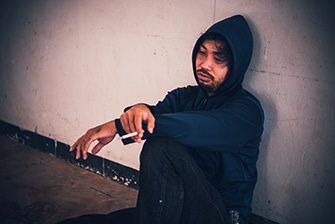Your Guide to Vicodin Addiction and Vicodin Withdrawal
Hydrocodone (also known by the brand name Vicodin®) has been the second-most commonly encountered opioid pharmaceutical in drug evidence since 2009, as reported by the Drug Enforcement Administration (DEA). Withdrawal from Vicodin can vary in length and symptoms depending on the length and severity of the addiction.
Vicodin is relatively easy to obtain and is perceived as safe when prescribed by a medical professional. If the drug is taken as prescribed for a limited time, Vicodin withdrawal symptoms will be either minimal or nonexistent. However, Vicodin is considered nearly as potent as morphine for pain relief and is therefore frequently abused for its strong opioid effects.
The National Institute on Drug Abuse (NIDA) states that “misinformation about the addictive properties of prescription opioids and the perception that prescription drugs are less harmful than illicit drugs” are possible contributors to the prevalence of Vicodin addiction.
How to Recognize Vicodin Addiction
Identifying Vicodin addiction is easy once you recognize the signs of Vicodin dependency. UCLA’s Semel Institute for Neuroscience and Human Behavior recognizes the following symptoms as behavioral signs of a Vicodin addiction.
- Taking more Vicodin than instructed
- Trying and failing to limit Vicodin use
- Making significant sacrifices to obtain more Vicodin
Physical Signs of Vicodin Addiction
Physical Vicodin addiction means an individual will experience physical withdrawal symptoms when they stop using Vicodin. Some of these include:
- Building a higher tolerance to Vicodin, meaning you require increasingly larger doses to feel the effects
- Impaired pain sensations
- Confusion
- Sedation and slowed breathing
- Withdrawal symptoms when dosages of the drug are decreased or ceased
What Happens During Vicodin Withdrawal
Withdrawal symptoms begin when Vicodin leaves the body completely, about 8 hours after ceasing use. The Vicodin withdrawal experience varies from patient to patient, but all patients can expect some withdrawal symptoms if they’ve been abusing Vicodin for a significant period of time. According to Addictions and Recovery, there are two phases of Vicodin withdrawal, acute and post-acute.
Acute Vicodin withdrawal begins about 12 hours after your last Vicodin use. Symptoms peak between days 3 and 5, and improve after 3-4 weeks. This stage of Vicodin withdrawal is comprised of mainly physical symptoms. These physical symptoms are common during acute Vicodin withdrawal:
- Physical tremors
- Appetite changes, like lessened hunger and heightened cravings for the drug
- Aches
- Hot or cold flashes
- Nausea
Post-Acute Vicodin withdrawal is less severe than acute Vicodin withdrawal and involves mainly emotional symptoms, but it can last up to two years. These can include anxiety, cravings and depression.
What is Post-Acute Withdrawal Syndrome (PAWS)?
After Vicodin detox, some patients experience a syndrome called PAWS (Post-Acute Withdrawal Syndrome). PAWS refers to any withdrawal symptoms that persist once acute withdrawal is over.
Usually, PAWS affects individuals who have been abusing large amounts of an addictive substance for a long period of time.
- Opioids like hydrocodone (Vicodin) can lead to PAWS if an individual does not take the proper steps during detox.
- Individuals who experience the full intensity of acute withdrawal are more likely to develop PAWS.
- Patients with co-occurring physical and/or mental health conditions are more susceptible to this withdrawal syndrome.
- PAWS can be exacerbated if acute emotional issues arise during the first year or years of recovery.
Symptoms of PAWS
- Strong cravings for Vicodin
- Feelings of exhaustion and fatigue
- Long-lasting cognitive impairment and difficulty focusing
- Irritability and hostility
- Depression
- Mood swings
- Anxiety
- Insomnia and irregular sleep patterns
- Lack of libido
- Inexplicable chronic pain
PAWS is a complex syndrome with no clearly-defined timelines. Some clients will experience no significant issues following the initial withdrawal from Vicodin, while others may struggle with post-acute withdrawal symptoms for years.
Can Medication-Assisted Detox Make Vicodin Withdrawal Easier?
If an individual chooses to quit opiate use cold turkey without any assistance, the Vicodin withdrawal experience will likely be more severe. Medication-assisted detox with the help of an onsite addictionologist is recommended to lessen discomfort and to ensure the safety of the patient and successful completion of the detox.
- During medication-assisted detox, the patient is weaned off of drugs in a safe, controlled environment.
- To lessen the unpleasant symptoms of Vicodin withdrawal, medication-assisted detox programs employ measured doses of methadone and buprenorphine.
- Many patients find psychological support from therapists and medical professionals to be extremely helpful during Vicodin detox.
About Cliffside Malibu
Knowing the facts about Vicodin addiction and Vicodin withdrawal makes it much easier to choose the treatment facility and program that best fits your needs. Depending on the length and severity of the addiction, individuals may decide that an inpatient treatment with medication-assisted detox is best for them and their needs.
Since no two addictions are the same, Cliffside Malibu offers an individualized treatment plan for each and every client. We are committed to providing the best care possible through.a continuum of care including medically supervised detox, residential treatment, day treatment, and outpatient services. Our program includes not only evidence-based treatment, but family therapy and holistic therapy, as well. Whether an individual is suffering from substance abuse and/or alcohol addiction, our programs are designed and structured to be a supportive environment in order to maintain sobriety.
In addition to world-class treatment, Cliffside Malibu offers luxury accommodations, a serene environment, five-star dining, and plentiful amenities. We understand that addiction treatment is a rigorous process. Therefore, we provide for your comfort and relaxation at every turn, allowing you to rejuvenate, to meet the demands of treatment with your greatest energy and attention.
For more information on Cliffside Malibu, visit cliffsidemalibu.com
